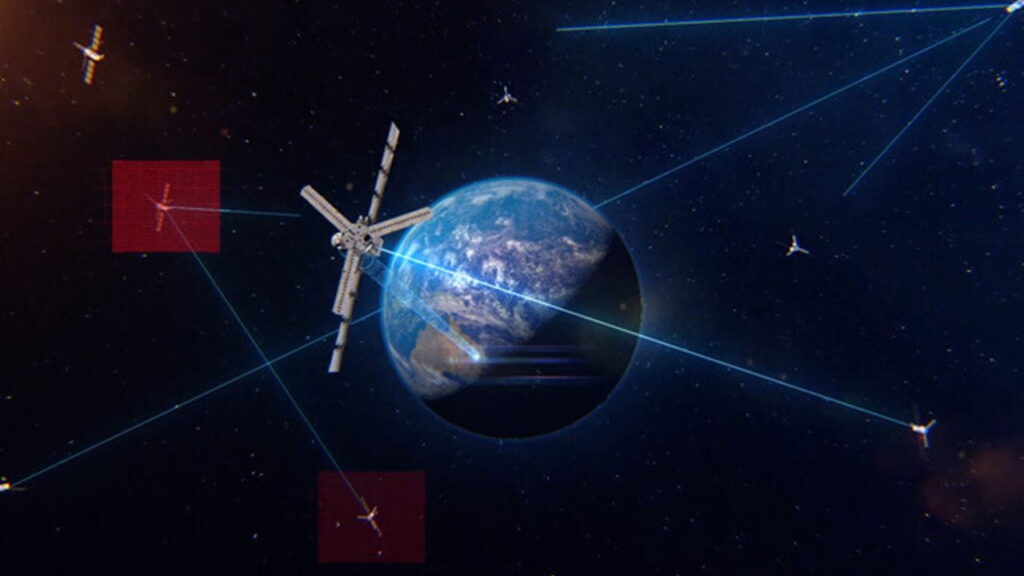
The Space Force is moving fast to develop a new set of missile warning/tracking satellites in MEO. (Graphic: Raytheon Technologies)
MilSat Symposium 2023 — The Space Force’s primary acquisition command intends to award contracts in late 2024 or early 2025 for some 18 “Epoch 2” missile warning/tracking satellites in medium Earth orbit (MEO) to flesh out a constellation that can provide global coverage, according to a senior Space Systems Command (SSC) official.
The Resilient Missile Warning/Missile Tracking – MEO (MEO MW/MT) constellation is being developed under the spiral development model, with one set of satellites with “new capabilities being placed on orbit every two to three years,” Col. Heather Bogstie, senior materiel leader at SSC’s Resilient Missile Warning, Tracking and Defense (MWTD) acquisition delta, said on Thursday.
“We can’t wait for perfect technology to be delivered on orbit every 10 years,” she told an audience at the MilSat Symposium here in Mountain View, Calif.
SSC last year initiated the effort to operate satellites in MEO as part of the service’s overhaul for how it does missile warning and tracking — expanding from previous programs that focused on a handful of satellites in geosynchronous Earth orbit (some 36,000 kilometers in altitude) to a network of hundreds of satellites in multiple orbits. MEO lies between the upper edge of low Earth orbit at 2,000 kilometers above the Earth and geosynchronous orbit.
Each spiral of satellites under the MEO program are called Epochs. Epoch 1 is essence transitions the SSC’s 2021 study, first reported by Breaking Defense, to a program of record, with Raytheon Intelligence & Space and Boeing’s Millennium Space Systems contracted in January to build MEO MW/MT Epoch 1 prototypes. In June, SSC awarded a $29 million sensor payload design contract to L3Harris Technologies, positioning the company as the third vendor.
“Our first delivery is Epoch 1, launching at the end of 2026. We will field nine satellites across two planes. These sensors will give us the latest and missile warning and tracking capabilities in several regions of the globe,” Bogstie said. “Epoch 2 will then deliver four additional planes of satellites, bringing us to a total of six planes and approximately 27 satellites. This configuration will become our baseline set of operational capabilities and give us coverage over the entire globe.”
Bogstie’s slide presentation showed that SSC plans to issue a draft request for proposals (RFP) for Epoch 2 later this fall, a final RFP in the summer of 2024, and make “at least one competitive award” in late 2024/early 2025.
Epoch 2 will emphasize “maturation of MW/MT sensors, optical crosslinks, data fusion, constellation mission management, [and] robust ground communication,” the slide said.
Bogstie explained that then Epoch 3, in the early 2030s, will replace the Epoch 1 birds, “with two new planes and satellites with newer fresh technology aimed at persistent simultaneous tracking and warning.”
According to the slides, SSC is making investments in five key technology programs under the MEO MW/MT effort:
- Focal plane arrays — Manufacturing, coatings, large format
- Constellation mission management
- Data correlation & fusion
- Optical crosslinks
- On-board processing
Bogstie noted that the MEO network is focused on providing low latency, meaning the ability to process and downlink very high volumes of data with minimal delay.
“Low latency is critical to enabling rapid reaction times and accurate target data,” she said. “Throughout the course of flight, our data is fused with other missile warning and tracking data, and provided to operators who will make sense of it. These operators rely on extremely accurate data to ensure they have properly characterized the missile type, its origin and its intended target. Finally, this target quality data will be used to engage our defensive systems and defeat these threats.”
Lastly, SSC is committed to early development of “a fully functional and robust ground system,” Bogstie stressed.
“We are striving to have it fully in place one year before, not after, we launch our first Epoch of satellites. We are actively fielding multiple ground relay stations around the globe, and working with our mission partners to be ready to ingest and fuse our new data,” she said.
Defense Department space programs traditionally have struggled to match ground-station and receiver availability with the deployment of the actual satellites — a problem that space acquisition czar Frank Calvelli has vowed to fix.








